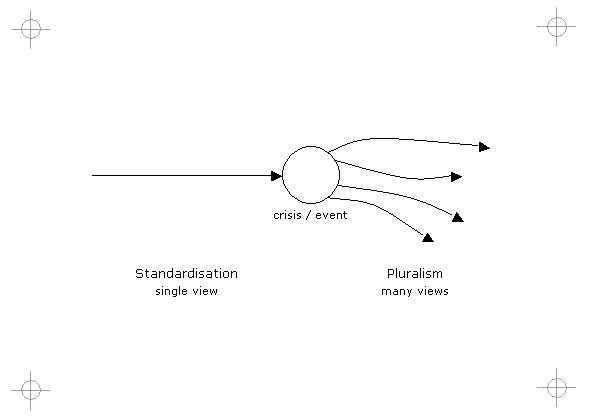|
Diagram
|
|
|

|
|
Title
|
|
|
Postmodern Pluralism
|
|
Building Architecture
|
|
|
Standardisation tends to lead towards a singular view. Eventually, a reaction to break away occurs when the forces shift towards pluralism - many views and values. Rather than maintaining the view that one way is right or dominant, the more popular view is towards tolerance of many views where none dominate.
|
|
Architecture Intensive Disciplines
|
|
|
A crisis will put pressure on efforts to standardise processes. Critics will point to the constraints caused by standardisation. This will lead to pluralism or tolerance of many views. One of the reasons why projects fail is the lack of adherence to a methodology. Yet, it is those who fail to apply a methodology who will likely blame the methodology for the project failure. Pluralism also helps us understand why consensus is difficult to achieve.
|
|
Case Study A: Large Corporate IT
|
|
|

|
|
|
Policies and procedures were put into place with quality assurance (QA) points. An architecture / integration team was established to assist developers and the formal Request procedures for change management. The process had been more strictly applied and aligned so that it was consistent on all platforms. However, not all managers agreed with this approach including business unit managers, IT managers and project managers. Even before the process was in place, it was already being blamed for lack of delivery despite the fact that some projects were already behind schedule.
As in the pattern, crisis facilitates an opportunity to question the standard. In this case, an alternative approach could replace a previous standard rather than result in pluralism. The pressure to seek pluralism will always exist but in large organisation sufficient measures can be put in place to resist it - for better or worse. The problem with this approach is that there are no layers of abstraction - values, principles and practices. The terminology used was singular - a "standard". Rather than establishing values with many principles and principles with possibly many practices, the approach taken was that there was "only one way".
|
|
Case Study B: Small Commercial Team
|
|
|

|
|
|
From the beginning the approach adopted was that of values, principles and practices. With smaller teams, this is easier to achieve. But the approach did make a difference. Each crisis became a learning experience to enrich the set of practices we adopted or to find exceptions. Rather than evaluate whether we were doing the right thing and wasting time debating these, we were simply building on a set of foundations. Pluralism was given expression and a "crisis" was simply a "node" to "branch out" from. The approach was organic and natural.
|
|
|


